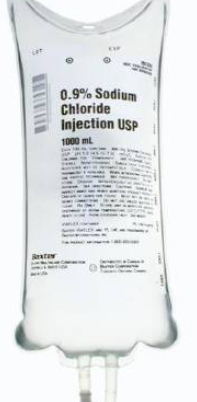
(BAXTER) Sodium Chloride 0.9% w/v (Viaflo Bag) Price
Active Substance: Sodium chloride .
Overview
Welcome to Dwaey, specifically on (BAXTER) Sodium Chloride 0.9% w/v (Viaflo Bag) page.
This medicine contains an important and useful components, as it consists of
Sodium chloride is available in the market in concentration
Name
Sodium chloride
Precaution
<p> Sodium chloride infusion should be administered with caution in patients with conditions associated with sodium retention, such as congestive heart failure, renal insufficiency, or liver cirrhosis. Frequent monitoring of electrolyte levels, fluid balance, and acid-base status is essential, particularly during prolonged therapy or high-volume administration. Use cautiously in geriatric patients, who may be more susceptible to fluid overload and hypertension. Care should also be taken when administering to patients with hypertension, pre-eclampsia, or those receiving corticosteroids or other sodium-retaining agents. </p>
Indication
<p> Sodium chloride intravenous solution is primarily indicated for the treatment and prevention of sodium and fluid depletion. It is commonly used in the management of dehydration, hypovolemia, shock, and metabolic alkalosis. It also serves as a vehicle for the delivery of other intravenous medications and for flushing intravenous catheters. In surgical and trauma settings, it helps restore blood volume and maintain electrolyte balance. In mild cases of hyponatremia or as part of parenteral nutrition, sodium chloride is often the solution of choice. </p>
Contra indication
<p> Sodium chloride infusion is contraindicated in patients with hypernatremia, fluid retention states, or severe renal impairment with oliguria or anuria. It should not be used in patients with conditions where sodium or water retention could exacerbate the disease, such as congestive heart failure or severe hypertension. In cases of pulmonary edema or cirrhosis with ascites, sodium chloride infusions may worsen the clinical condition and are best avoided or used with strict monitoring. </p>
Side Effect
<p> Possible side effects include local infusion site reactions like pain, swelling, or phlebitis. Systemically, over-administration may result in hypernatremia, fluid overload, pulmonary edema, and hypertension. In patients with renal insufficiency, excessive sodium may accumulate, increasing the risk of metabolic disturbances. Rarely, allergic reactions such as rash or fever can occur. Long-term use without appropriate monitoring can result in dilutional acidosis or electrolyte imbalance. </p>
Pregnancy Category ID
Information not available
Mode of Action
<p> Sodium chloride dissociates in solution to provide sodium (Na⁺) and chloride (Cl⁻) ions, which are essential electrolytes in the extracellular fluid. Sodium plays a critical role in the regulation of blood volume, blood pressure, and nerve and muscle function, while chloride maintains acid-base balance and osmotic pressure. The infusion restores lost electrolytes and fluids, helping to normalize plasma volume and osmolarity during hypovolemia or dehydration. </p>
Interaction
<p> Sodium chloride may interact with medications that affect fluid and electrolyte balance, including corticosteroids, NSAIDs, ACE inhibitors, and diuretics. These interactions may increase the risk of fluid overload, hypertension, or electrolyte imbalances. Care should be taken when co-administering with drugs that increase sodium retention. Compatibility must be confirmed when mixing with other intravenous drugs to prevent precipitation or chemical inactivation. </p>
Pregnancy Category Note
<p> Sodium chloride infusion is generally considered safe during pregnancy when used under medical supervision. It is classified as FDA Pregnancy Category C, as controlled studies in pregnant women are lacking. However, since sodium and chloride are naturally occurring electrolytes necessary for maternal and fetal health, the risk is low when administered in therapeutic doses. Care should be taken to avoid fluid overload and hypertension in pregnant women, particularly those with pre-existing conditions such as pre-eclampsia. </p>
Adult Dose
<p> The usual adult dose of sodium chloride 0.9% varies based on clinical need and condition. For fluid resuscitation, 500 mL to 1000 mL may be infused rapidly. Maintenance doses typically range from 1.5 to 3 liters per day, depending on hydration status, electrolyte levels, and clinical context. Dosing should be adjusted in patients with cardiovascular or renal compromise to prevent fluid overload. </p>
Child Dose
<p> Pediatric dosing is weight-based, commonly ranging from 20 to 30 mL/kg for resuscitation or 100 mL/kg/day for maintenance. In neonates and infants, careful monitoring of sodium levels, fluid status, and urine output is necessary. The infusion rate should be adjusted according to the child’s age, weight, and underlying medical condition, with close supervision in pediatric care settings. </p>
Renal Dose
<p> In patients with renal impairment, sodium chloride infusions should be used cautiously. The volume and rate of administration must be reduced to prevent sodium and fluid accumulation. Frequent monitoring of serum sodium, potassium, and fluid status is essential. In severe renal failure or dialysis-dependent patients, alternative fluid strategies may be more appropriate based on individualized needs. </p>
Administration
<p> Sodium chloride solution is administered intravenously under aseptic conditions. It may be given via peripheral or central venous access depending on the volume and rate of infusion. The solution should be clear and free of particulates; do not use if discolored or if the container is compromised. Use an infusion pump for controlled delivery and adjust the rate according to clinical response and laboratory results. Discard any unused portion to prevent contamination. </p>
